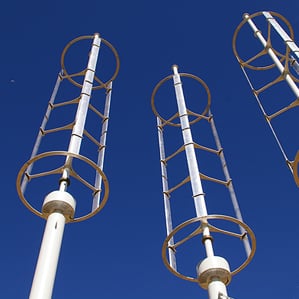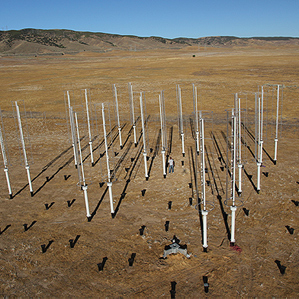Will Vertical Turbines Make More of the Wind?
The remote Alaskan village of Igiugig—home to about 50 people—will be the first to demonstrate a new approach to wind power that could boost power output and, its inventors say, just might make it more affordable.

For decades, the trend across the wind industry has been to make wind turbines larger and larger—because it has improved efficiency and helped lower costs.
John Dabiri, a professor of aeronautical and bioengineering at Caltech, has a heretical idea. He thinks the way to lower the cost of wind power is to use small vertical-axis wind turbines, while using computer models to optimize their arrangement in a wind farm so that each turbine boosts the power output of its neighbors.
Dabiri has demonstrated the basic idea at a 24-turbine test plot in southern California. Grants totaling $6 million from the Gordon and Betty Moore Foundation and the U.S. Department of Defense will allow him to see if the approach can lower wind power costs in Igiugig. The first 10 turbines will be installed this year, and the goal is to eventually install 50 to 70 turbines, which would produce roughly as much power as the diesel generators the village uses now. Dabiri is also installing turbines at an existing wind farm in Palm Springs, California, using his models to generate power by putting up new turbines between existing ones.
Ordinarily, as wind passes around and through a wind turbine, it produces turbulence that buffets downstream turbines, reducing their power output and increasing wear and tear. Dabiri says that vertical-axis turbines produce a wake that can be beneficial to other turbines, if they’re positioned correctly.
The blades of this type of wind turbine are arranged vertically—like poles on a carousel rather than spokes on a wheel, as with conventional wind turbines. Wind moving around the vertical-axis turbines speeds up, and the vertical arrangement of the blades on downstream wind turbines allows them to effectively catch that wind, speed up, and generate more power. (The spinning blades of a conventional wind turbine would only catch some of this faster wind as they pass through it—this actually hurts the turbine’s performance because it increases stress on the blades.) The arrangement makes it possible to pack more turbines onto a piece of land.

Dabiri’s wind turbines are 10 meters tall and generate three to five kilowatts, unlike the 100-meter-tall, multi-megawatt machines in conventional wind farms. He says the smaller ones are easier to manufacture and could cost less than conventional ones if produced on a large scale. He also says maintenance costs could be less because the generator sits on the ground, rather than at the top of a 100-meter tower, and thus is easier to access. The performance of the wind farm at Igiugig will help determine whether his estimates of maintenance costs are correct.
Dabiri says small, vertical wind turbines have other advantages. While the noise of conventional wind turbines has led some communities to campaign to tear them down, his turbines are “almost inaudible,” he says. They’re also less likely to kill birds. And their short profile has attracted a $1 million grant from the Department of Defense to study their use on military bases. Because they’re shorter, they interfere less with helicopter operations and with radar than conventional wind turbines.
The approach, however, faces some challenges. Vertical-axis wind turbines aren’t as efficient as conventional ones—half of the time the blades are actually moving against the wind, rather than generating the lift needed spin a generator. As the blades alternatively catch the wind and then move against it, they create wear and tear on the structure, says Fort Felker, director of the National Wind Technology Center at the National Renewable Energy Laboratory. Dabiri, and researchers such as Alexander Smits at Princeton University, say they are working on improved turbine designs to address some of these issues.
Felker notes that Dabiri’s approach will also require installing a thousand times more wind turbines, requiring potentially millions of wind turbines rather than thousands to generate significant fractions of U.S. power supply. And he notes that, over the last several decades, the wind industry has demonstrated that making ever larger wind turbines lowers costs (“Novel Designs are Taking Wind Power to the Next Level,” “Supersized Wind Turbines Head Out to Sea,” and “The Quest for the Monster Wind Turbine Blade.” “Going in the other direction, I believe, will not be successful,” he says. “I don’t think the math works out.”
Felker thinks that Dabiri’s approach might prove fitting for small, isolated places like Igiugig, where simpler construction and maintenance might be important. “But if you’re trying to transform the overall energy economy,” he says, “you’ve got to go big.”
Keep Reading
Most Popular
Large language models can do jaw-dropping things. But nobody knows exactly why.
And that's a problem. Figuring it out is one of the biggest scientific puzzles of our time and a crucial step towards controlling more powerful future models.
The problem with plug-in hybrids? Their drivers.
Plug-in hybrids are often sold as a transition to EVs, but new data from Europe shows we’re still underestimating the emissions they produce.
How scientists traced a mysterious covid case back to six toilets
When wastewater surveillance turns into a hunt for a single infected individual, the ethics get tricky.
Google DeepMind’s new generative model makes Super Mario–like games from scratch
Genie learns how to control games by watching hours and hours of video. It could help train next-gen robots too.
Stay connected
Get the latest updates from
MIT Technology Review
Discover special offers, top stories, upcoming events, and more.